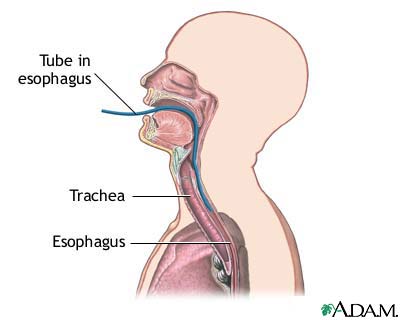Health Library
Esophageal pH monitoring
pH monitoring - esophageal; Esophageal acidity test
Esophageal pH monitoring is a test that measures how often stomach acid enters the tube that leads from the mouth to the stomach (called the esophagus). The test also measures how long the acid stays there.
Images

I Would Like to Learn About:
How the Test is Performed
A thin tube is passed through your nose or mouth to your stomach. The tube is then pulled back into your esophagus. A monitor attached to the tube measures the acid level (pH) in your esophagus.
You will wear the monitor on a strap and record your symptoms and activities over the next 24 hours in a diary. You will return to the hospital the next day and the tube will be removed. The information from the monitor will be compared with your diary notes.
Infants and children may need to stay in the hospital for the esophageal pH monitoring test.
A newer method of monitoring esophageal acid (pH monitoring) is by use of a wireless pH probe. This is called the Bravo pH monitor system.
- This capsule-like device is attached to the lining of the upper esophagus with an endoscope.
- It remains in the esophagus where it measures acidity and transmits pH levels to a recording device worn on the wrist.
- The capsule falls off after a 4 to 10 days and moves down through gastrointestinal tract. It is then expelled with a bowel movement and flushed down the toilet.
How to Prepare for the Test
Your health care provider will ask you to not eat or drink after midnight before the test. You should also avoid smoking.
Some medicines may change the test results. Your provider may ask you to not take these for between 24 hours and 2 weeks (or more) before the test. You also may be told to avoid alcohol. Medicines that you may need to stop include:
- Adrenergic blockers
- Antacids
- Anticholinergics
- Cholinergics
- Corticosteroids
- H2 blockers
- NSAIDs
- Proton pump inhibitors
Do not stop taking any medicine unless told to do so by your provider.
How the Test will Feel
You briefly feel like gagging as the tube is passed through your throat.
The Bravo pH monitor causes no discomfort.
Why the Test is Performed
Esophageal pH monitoring is used to check how much stomach acid is entering the esophagus. It also checks how well the acid is cleared downward into the stomach. It is a test for gastroesophageal reflux disease (GERD).
In infants, this test is also used to check for GERD and other problems related to excessive crying.
Normal Results
Normal value ranges may vary depending on the lab doing the test. Talk to your provider about the meaning of your specific test results.
What Abnormal Results Mean
Increased acid in the esophagus may be related to:
- Barrett esophagus
- Difficulty swallowing (dysphagia)
- Esophageal scarring
- Gastroesophageal reflux disease (GERD)
- Heartburn
- Reflux esophagitis
You may need to have the following tests if your provider suspects esophagitis:
- Barium swallow
- Esophagogastroduodenoscopy (also called upper GI endoscopy)
Risks
Rarely, the following may occur:
- Arrhythmias during insertion of the tube
- Breathing in of vomit if the catheter causes vomiting
Related Information
HeartburnGastroesophageal reflux disease
Excessive crying in infants
Esophagitis
EGD - esophagogastroduodenoscopy
Upper GI and small bowel series
References
Falk GW, Katzka DA. Diseases of the esophagus. In: Goldman L, Schafer AI, eds. Goldman-Cecil Medicine. 26th ed. Philadelphia, PA: Elsevier; 2020:chap 129.
Kavitt RT, Vaezi MF. Diseases of the esophagus. In: Flint PW, Francis HW, Haughey BH, et al, eds. Cummings Otolaryngology: Head and Neck Surgery. 7th ed. Philadelphia, PA: Elsevier; 2021:chap 68.
Richter JE, Vaezi MF. Gastroesophageal reflux disease. In: Feldman M, Friedman LS, Brandt LJ, eds. Sleisenger and Fordtran's Gastrointestinal and Liver Disease. 11th ed. Philadelphia, PA: Elsevier; 2021:chap 46.
BACK TO TOPReview Date: 11/2/2022
Reviewed By: Michael M. Phillips, MD, Emeritus Professor of Medicine, The George Washington University School of Medicine, Washington, DC. Also reviewed by David C. Dugdale, MD, Medical Director, Brenda Conaway, Editorial Director, and the A.D.A.M. Editorial team.
 | A.D.A.M., Inc. is accredited by URAC, for Health Content Provider (www.urac.org). URAC's accreditation program is an independent audit to verify that A.D.A.M. follows rigorous standards of quality and accountability. A.D.A.M. is among the first to achieve this important distinction for online health information and services. Learn more about A.D.A.M.'s editorial policy, editorial process and privacy policy. A.D.A.M. is also a founding member of Hi-Ethics. This site complies with the HONcode standard for trustworthy health information: verify here. |
The information provided herein should not be used during any medical emergency or for the diagnosis or treatment of any medical condition. A licensed medical professional should be consulted for diagnosis and treatment of any and all medical conditions. Links to other sites are provided for information only -- they do not constitute endorsements of those other sites. No warranty of any kind, either expressed or implied, is made as to the accuracy, reliability, timeliness, or correctness of any translations made by a third-party service of the information provided herein into any other language. © 1997- 2025 A.D.A.M., a business unit of Ebix, Inc. Any duplication or distribution of the information contained herein is strictly prohibited.
